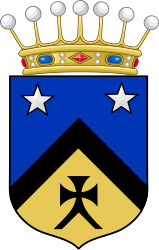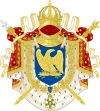
Ajaccio is the capital and largest city of Corsica, France. It forms a French commune, prefecture of the department of Corse-du-Sud, and head office of the Collectivité territoriale de Corse. It is also the largest settlement on the island. Ajaccio is located on the west coast of the island of Corsica, 210 nautical miles (390 km) southeast of Marseille.

The House of Bonaparte is a former imperial and royal European dynasty of Corsican origin. It was founded in 1804 by Napoleon I, the son of Corsican nobleman Carlo Buonaparte and Letizia Buonaparte. Napoleon was a French military leader who rose to power during the French Revolution and who, in 1804, transformed the First French Republic into the First French Empire, five years after his coup d'état of November 1799. Napoleon and the Grande Armée had to fight against every major European power and dominated continental Europe through a series of military victories during the Napoleonic Wars. He installed members of his family on the thrones of client states, expanding the power of the dynasty.

Lucien Bonaparte, 1st Prince of Canino and Musignano, was a French politician and diplomat of the French Revolution and the Consulate. He served as Minister of the Interior from 1799 to 1800 and as the president of the Council of Five Hundred in 1799.

Joseph Cardinal Fesch, Prince of the Empire was a French priest and diplomat, who was the maternal half-uncle of Napoleon Bonaparte. In the wake of his nephew, he became Archbishop of Lyon and cardinal. He was also one of the most famous art collectors of his period, remembered for having established the Musée Fesch in Ajaccio, which remains one of the most important Napoleonic collections of art.
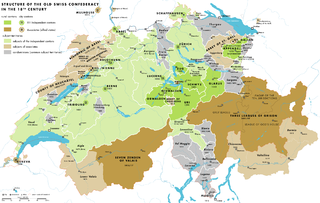
The early modern history of the Old Swiss Confederacy and its constituent Thirteen Cantons encompasses the time of the Thirty Years' War (1618–1648) until the French invasion of 1798.

Patricianship, the quality of belonging to a patriciate, began in the ancient world, where cities such as Ancient Rome had a social class of patrician families, whose members were initially the only people allowed to exercise many political functions. In the rise of European towns in the 12th and 13th centuries, the patriciate, a limited group of families with a special constitutional position, in Henri Pirenne's view, was the motive force. In 19th century Central Europe, the term had become synonymous with the upper Bourgeoisie and cannot be interchanged with the medieval patriciate in Central Europe. In the maritime republics of the Italian Peninsula as well as in German-speaking parts of Europe, the patricians were as a matter of fact the ruling body of the medieval town. Particularly in Italy, they were part of the nobility.

Karl Theodor Anton Maria von Dalberg was a Catholic German bishop and statesman. In various capacities, he served as Prince-Archbishop of Regensburg, Arch-Chancellor of the Holy Roman Empire, Bishop of Constance and Worms, Prince-Primate of the Confederation of the Rhine and grand duke of Frankfurt. Dalberg was the last Archbishop-Elector of Mainz.

Carlo Maria Buonaparte or Charles-Marie Bonaparte was a Corsican attorney best known as the father of Napoleon Bonaparte and grandfather of Napoleon III.
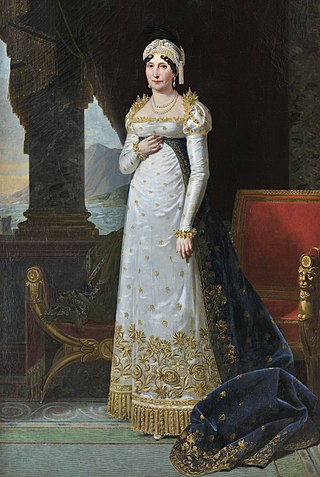
Maria-Letizia Bonaparte, known as Letizia Bonaparte, was a Corsican noblewoman and the mother of Napoleon I of France. She received the title "Madame Mère" due to her status as the Emperor's mother.

The Diocese of Sion is a Latin Catholic ecclesiastical territory in the canton of Valais, Switzerland. It is the oldest bishopric in the country and one of the oldest north of the Alps. The history of the Bishops of Sion, of the Abbey of St. Maurice of Valais as a whole are inextricably intertwined.

The Diocese of Ajaccio is a Latin Church ecclesiastical jurisdiction or diocese of the Catholic Church in France. The diocese comprises the whole of the island of Corsica.
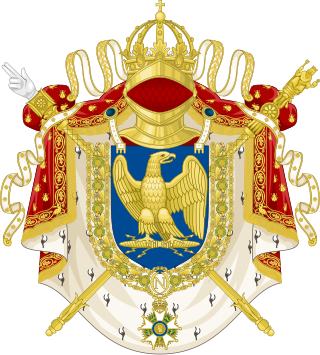
As Emperor of the French, Napoleon I created titles in a newly established noblesse impériale to institute a stable elite in the First French Empire, after the instability resulting from the French Revolution.
Switzerland, officially the Swiss Confederation, is a collection of semi-autonomous cantons. As membership of the confederation has fluctuated throughout history, each of these cantons has its own unique history and nobility. Typically, each canton had its own constitution, currency, jurisdiction, habits, customs, history, and nobility.
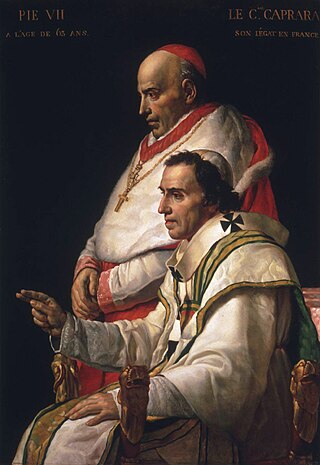
The relationship between Napoleon and the Catholic Church was an important aspect of his rule.

The musée Fesch is the central museum of fine arts in Ajaccio on Corsica. Located within the gated Palais Fesch, it is in the town's Borgu d'Ajaccio quarter. It was established by Napoleon I's uncle, cardinal Joseph Fesch, in Fesch's birthplace.

Ludwig Erdwin Seyler was a Hamburg merchant, merchant banker and politician. He was by marriage a member of the Hanseatic Berenberg dynasty, and was a partner in the Hamburg firm Joh. Berenberg, Gossler & Co. for 48 years (1788–1836), for 46 years as the company's senior partner. The company name was amended in 1791 to reflect him becoming a partner and has remained unchanged since; he "is practically the 'Co.' in the company name." Seyler was one of the first merchants and bankers from modern Germany to establish trade relations with the United States and East Asia. Much of the company's wealth derived from their position as leading sugar importers from the Americas to the North European market, in combination with their activities as merchants bankers. Seyler was one of Hamburg's leading merchants during the Napoleonic Wars and held several political offices. He served as a member of the French-appointed council of Hamburg and after the Napoleonic Wars as the President of the Commercial Deputation, one of the city-state's main political bodies. Ludwig Seyler was a son of the Swiss-born theatre director Abel Seyler and a son-in-law of the bankers Johann Hinrich Gossler and Elisabeth Berenberg through his marriage to their eldest daughter Anna Henriette Gossler.

The Seyler family is a Swiss family, originally a patrician family from Liestal near Basel. Family members served as councillors and Schultheißen of Liestal from the 15th century, later also as members of the Grand Council of Basel. A Hamburg branch descended from the banker and renowned theatre director Abel Seyler became by marriage a part of the Berenberg banking dynasty, co-owners of Berenberg Bank and part of Hamburg's ruling class of Hanseaten.

The papal nobility are the aristocracy of the Holy See, composed of persons holding titles bestowed by the Pope. From the Middle Ages into the nineteenth century, the papacy held direct temporal power in the Papal States, and many titles of papal nobility were derived from fiefs with territorial privileges attached. During this time, the Pope also bestowed ancient civic titles such as patrician. Today, the Pope still exercises authority to grant titles with territorial designations, although these are purely nominal and the privileges enjoyed by the holders pertain to styles of address and heraldry. Additionally, the Pope grants personal and familial titles that carry no territorial designation. Their titles being merely honorific, the modern papal nobility includes descendants of ancient Roman families as well as notable Catholics from many countries. All pontifical noble titles are within the personal gift of the pontiff, and are not recorded in the Official Acts of the Holy See.
Johann Rudolf Faesch was a Swiss silk merchant, politician and diplomat from Basel. He was part of several Swiss diplomatic missions and held numerous high offices of the city. In 1630 he became head of the guild and from 1636 to his death in 1659 he was Burgomaster of Basel alongside his rival Johann Rudolf Wettstein. Faesch led the council's pro-French faction while Wettstein led the pro-Confederacy faction.

Von der Mühll or Von der Mühl is a Swiss patrician and noble family.










